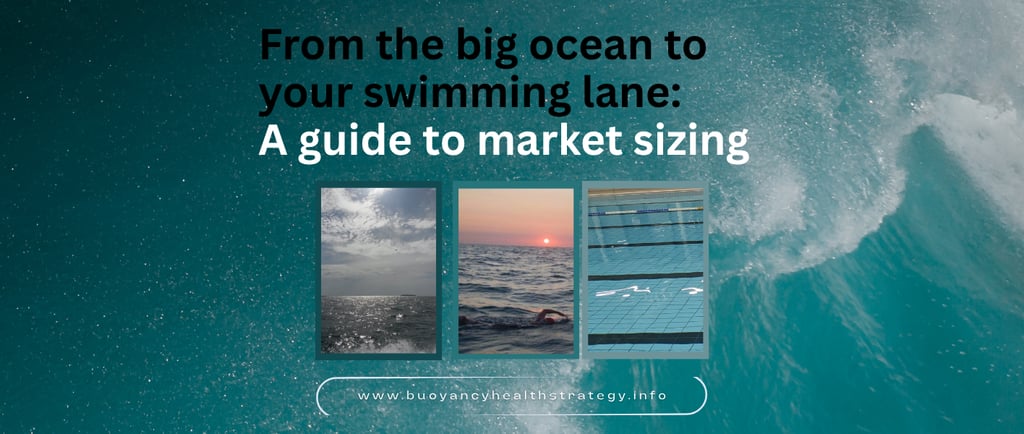From the big ocean to your swimming lane: A guide to market sizing
Matthias Winker
7/17/20253 min read


I had many conversations with Founders, CEO's, and teams from healthtech and medtech companies. Most have a clear vision and their solutions sound compelling. Yet, for many early-stage and growth teams, one question came up regularly:
"How big is our market, and who should we focus on first?"
Sounds easy? Get to Excel, put in some numbers based on internet research, and go for all of it. OR use a strategic compass to navigate the market sizing question.
Defining the Total Addressable Market (TAM), Serviceable Available Market (SAM), and Serviceable Obtainable Market (SOM) isn't just a theoretical exercise, it's the bedrock for actionable growth.
Let's dive in, using a healthtech example as our guide. A young company aims to build a digital companion to support people of GLP-1 drugs. How could they approach the TAM, SAM, SOM exercise?
Step 1: Know your use case in the real world
Before jumping into numbers, it's important to truly understand where your solution fits in the real world. Think of it as knowing the exact depth and currents of your target waters.
Is the solution designed for patients prescribed GLP-2 drugs in primary care?
Or those being managed in specialist obesity clinics?
Is it for early-stage users just starting treatment, or long-term users needing sustained behaviour change?
These aren't minor details. Your product's position in the clinical and patient journey will fundamentally shape your market definition at every level.
Step 2: Define your TAM - The entire ocean
TAM = everyone your product could help, in theory. It's the maximum revenue opportunity if you captured 100% of the market.
For our example, the TAM might be:
All patients eligible for GLP-1 agonists (like Ozempic, Wegovy, etc.).
Or even broader: all adults with obesity or overweight considering medical treatment globally.
Be aware of going too wide. TAM is useful for vision-setting, but not for go-to-market focus. Don't get lost at sea. Remember, the TAM is about vision, not immediate focus.
Here are some key questions for you:
How many people could benefit from this intervention globally or nationally?
What assumptions are you making about access, eligibility, and demand?
Step 3: Define your SAM - The reachable waters
SAM = The segment of the TAM that you can realistically serve, given your current product and business model. It's the part of the ocean where you can actually sail.
For our example of the weight-loss companion, the SAM narrows to:
Patients with access to digital health platforms.
Users in health systems where GLP-1 prescribing is common.
English-speaking populations with smartphone access.
If you're planning to partner with employers or payers, your SAM shifts again. It's not just the patient, it's the channel that matters. Your SAM reflects key strategic decisions about your target geographies, channels, and operational capabilities.
Here are some key decisions to consider:
Which countries or regions will you target first?
What are the relevant prescribing patterns and care models in those areas?
Are there digital reimbursement or procurement pathways in place?
Step 4: Define your SOM - Your current swimming lane
SOM = The people you can realistically reach and win within the next 12-24 months. This is your go-to-market swimming lane.
For our example, the SOM could be:
10,000 GLP-1 users across two UK regions where you have active provider pilots underway.
Five employers with obesity management programmes, who have signed letters of intent.
This is where real-world constraints come in: budget, regulatory approvals, clinical partnerships, marketing reach, team capacity.
Here are some key questions to consider:
Where do you already have traction, interest, or relationship?
What proof points do you need to expand?
What's your realistic commercial capacity right now?
Why does this buoyancy matters for you
Defining TAM, SAM, and SOM isn't merely a pitch deck exercise, although one part of it. It's a critical strategic tool to help you to:
Identify and prioritise the most valuable customer segments.
Align internal focus and external messaging.
Anchor your product and commercial decisions in real-world logic.
In other words, it stops you from chasing the entire ocean and helps you find your lane.
Click here to download a free workshop template to guide your internal thinking or strategic discussions with advisors. (no email, no credit card details)
If you're working through these questions and need a sounding board, I’d be happy to help. Defining your market is as much about decisions as it is about data and sometimes, an outside perspective helps you find your current.
Buoyancy Health Strategy
Steady. Strategic. Scalable Healthcare Growth
© 2025 Buoyancy Health Strategy Ltd. All rights reserved.
